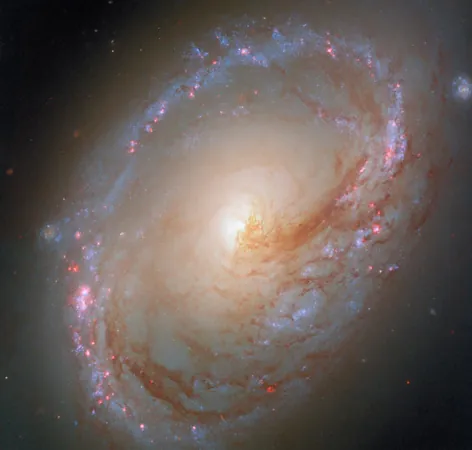
Hubble Space Telescope Captures Breathtaking New Image of Messier 96
2025-08-25
Author: Olivia
A Stellar Spectacle in Leo
In a stunning display of cosmic artistry, astronomers utilizing the NASA/ESA Hubble Space Telescope have unveiled an incredibly detailed image of the asymmetric spiral galaxy Messier 96.
A Journey Through Time and Space
Located about 34 million light-years away in the constellation Leo, Messier 96 is a captivating marvel of the universe. Discovered by French astronomer Pierre Méchain in March 1781, it was swiftly included in Charles Messier’s esteemed catalogue just four days later.
Size and Significance
Known by multiple names—NGC 3368, LEDA 32192, or simply M96—this galaxy stretches around 100,000 light-years across, roughly equivalent to our own Milky Way. With an estimated mass of 80 billion solar masses, it stands as a dominant figure in the Leo I galaxy group, also referred to as the M96 group.
The Dance of Gravity
Messier 96 resembles a cosmic maelstrom, its glowing gas swirling amidst dark dust that spirals inward toward its core. This galaxy showcases distinct asymmetry; its dust and gas are distributed unevenly, with spiral arms that exhibit an odd balance, likely influenced by the gravitational pull of neighboring galaxies in its group.
A New Perspective on Cosmic Formation
Experts from Hubble have noted, 'The gravitational interactions with nearby galaxies may account for Messier 96’s peculiar gas and dust distribution and its asymmetric spiral arms.' This latest Hubble image, enriched with ultraviolet and optical observations, highlights these striking characteristics.
Building a Cosmic Legacy
This isn't Hubble's first encounter with Messier 96; previous images were released in 2015 and 2018. Each new snapshot adds layers of data, offering an increasingly intricate and scientifically valuable glimpse into the galaxy.
Illuminating Star Formation
The latest image reveals dazzling bubbles of pink gas surrounding hot, young, massive stars, illuminating a ring of star birth in the galaxy's outskirts. These young stars remain cloaked within the very gas clouds from which they originated.
Unlocking Galactic Secrets
The innovative data featured in this new image will be pivotal in studying the intricate process of star formation within colossal dusty gas clouds, how dust affects starlight, and the influence of stars on their cosmic environments. Messier 96 continues to inspire awe and curiosity among astronomers and enthusiasts alike.









 Brasil (PT)
Brasil (PT)
 Canada (EN)
Canada (EN)
 Chile (ES)
Chile (ES)
 Česko (CS)
Česko (CS)
 대한민국 (KO)
대한민국 (KO)
 España (ES)
España (ES)
 France (FR)
France (FR)
 Hong Kong (EN)
Hong Kong (EN)
 Italia (IT)
Italia (IT)
 日本 (JA)
日本 (JA)
 Magyarország (HU)
Magyarország (HU)
 Norge (NO)
Norge (NO)
 Polska (PL)
Polska (PL)
 Schweiz (DE)
Schweiz (DE)
 Singapore (EN)
Singapore (EN)
 Sverige (SV)
Sverige (SV)
 Suomi (FI)
Suomi (FI)
 Türkiye (TR)
Türkiye (TR)
 الإمارات العربية المتحدة (AR)
الإمارات العربية المتحدة (AR)